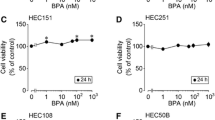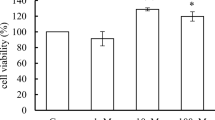Abstract
Fluorene-9-bisphenol (BHPF), a new derivative of bisphenol A (BPA), has been introduced for treatment with estrogen-related tumors, such as endometrial cancer. This study investigated the potential mechanism underlying the action of BHPF against endometrial cancer in vitro. We used the cell counting kit-8 (CCK8) method on Ishikawa cells to screen sub-lethal doses of BHPF and established the optimal concentration at which BHPF influenced the proliferation of Ishikawa cells. Effect of BHPF on cell migration and invasion was investigated by cell scratch assay and transwell assay, respectively. Expression levels of epithelial-mesenchymal transition (EMT)–related proteins were detected by Western blot analysis. BHPF was found to inhibit the proliferation of Ishikawa cells, whose migration and invasion abilities were also reduced. Western blot indicated that BHPF can significantly inhibit the EMT process of Ishikawa cells by blocking transforming growth factor-β (TGF-β) signaling pathway. This is the first report of the effect of BHPF on the biological behavior of endometrial cancer cells and its inhibition of endometrial cancer progression by repressing both endometrial cell proliferation and epithelial-mesenchymal transition, hence suggesting it as a novel anti-cancer drug.

Schematic representation of the molecular basis underlying BHPF treatment. BHPF repressed the EMT process by regulating EMT-related genes, such as E-cadherin, N-cadherin, and vimentin as well as the TGF-β signaling pathway–related genes, including p-Smad2/3 and slug, in a BHPF-dependent manner.





Similar content being viewed by others
References
Afrin S, Giampieri F, Gasparrini M, Forbes-Hernandez TY, Cianciosi D, Reboredo-Rodriguez P, Zhang J, Manna PP, Daglia M, Atanasov AG et al. (2018) Dietary phytochemicals in colorectal cancer prevention and treatment: A focus on the molecular mechanisms involved. Biotechnology advances. https://doi.org/10.1016/j.biotechadv.2018.11.011
Alblas M, Velt KB, Pashayan N, Widschwendter M, Steyerberg EW, Vergouwe Y (2018) Prediction models for endometrial cancer for the general population or symptomatic women: a systematic review. Crit Rev Oncol Hematol 126:92–99
Bharti R, Dey G, Mandal M (2016) Cancer development, chemoresistance, epithelial to mesenchymal transition and stem cells: a snapshot of IL-6 mediated involvement. Cancer Lett 375(1):51–61
Bin C, Xiaofeng H, Wanzi X (2018) The effect of microRNA-129 on the migration and invasion in NSCLC cells and its mechanism. Exp Lung Res:1–8
Brabletz T, Kalluri R, Nieto MA, Weinberg RA (2018) EMT in cancer. Nat Rev Cancer 18(2):128–134
Campbell K (2018) Contribution of epithelial-mesenchymal transitions to organogenesis and cancer metastasis. Curr Opin Cell Biol 55:30–35
Chen C, Zhao S, Karnad A, Freeman JW (2018) The biology and role of CD44 in cancer progression: therapeutic implications. J Hematol Oncol 11(1):64
Chlebowski RT, Schottinger JE, Shi J, Chung J, Haque R (2015) Aromatase inhibitors, tamoxifen, and endometrial cancer in breast cancer survivors. Cancer 121(13):2147–2155
Gu CJ, Xie F, Zhang B, Yang HL, Cheng J, He YY, Zhu XY, Li DJ, Li MQ (2018) High glucose promotes epithelial-mesenchymal transition of uterus endometrial cancer cells by increasing ER/GLUT4-mediated VEGF secretion. Cell Physiol Biochem 50(2):706–720
Ismiil N, Rasty G, Ghorab Z, Nofech-Mozes S, Bernardini M, Ackerman I, Thomas G, Covens A, Khalifa MA (2007) Adenomyosis involved by endometrial adenocarcinoma is a significant risk factor for deep myometrial invasion. Ann Diagn Pathol 11(4):252–257
Karlsson MC, Gonzalez SF, Welin J, Fuxe J (2017) Epithelial-mesenchymal transition in cancer metastasis through the lymphatic system. Mol Oncol 11(7):781–791
Klauzinska M, Castro NP, Rangel MC, Spike BT, Gray PC, Bertolette D, Cuttitta F, Salomon D (2014) The multifaceted role of the embryonic gene Cripto-1 in cancer, stem cells and epithelial-mesenchymal transition. Semin Cancer Biol 29:51–58
Li C, Ma H, Wang Y, Cao Z, Graves-Deal R, Powell AE, Starchenko A, Ayers GD, Washington MK, Kamath V, Desai K, Gerdes MJ, Solnica-Krezel L, Coffey RJ (2014) Excess PLAC8 promotes an unconventional ERK2-dependent EMT in colon cancer. J Clin Invest 124(5):2172–2187
Li J, Zhu Q, Yang B, Ning C, Liu X, Luo X, Chen X (2018) Risk factors for ovarian involvement in young and premenopausal endometrioid endometrial cancer patients. Eur J Obstet Gynecol Reprod Biol 222:151–154
Mali AV, Padhye SB, Anant S, Hegde MV, Kadam SS (2019) Anticancer and antimetastatic potential of enterolactone: clinical, preclinical and mechanistic perspectives. Eur J Pharmacol 852:107–124
Mallini P, Lennard T, Kirby J, Meeson A (2014) Epithelial-to-mesenchymal transition: what is the impact on breast cancer stem cells and drug resistance. Cancer Treat Rev 40(3):341–348
Mariscal, J., P. Fernandez-Puente, V. Calamia, A. Abalo, M. Santacana, X. Matias-Guiu, R. Lopez-Lopez, A. Gil-Moreno, L. Alonso-Alconada, and M. Abal (2018) Proteomic characterization of epithelial-like extracellular vesicles in advanced endometrial cancer. J Proteome Res
Menendez JA, Oza BP, Atlas E, Verma VA, Mehmi I, Lupu R (2004) Inhibition of tumour-associated fatty acid synthase activity antagonizes estradiol- and tamoxifen-induced agonist transactivation of estrogen receptor (ER) in human endometrial adenocarcinoma cells. Oncogene 23(28):4945–4958
Mitra P, Kalailingam P, Tan HB, Thanabalu T (2018) Overexpression of GRB2 enhances epithelial to mesenchymal transition of A549 cells by upregulating SNAIL expression. Cells 7(8)
Morice P, Leary A, Creutzberg C, Abu-Rustum N, Darai E (2016) Endometrial cancer. Lancet 387(10023):1094–1108
Muppala S, Xiao R, Krukovets I, Verbovetsky D, Yendamuri R, Habib N, Raman P, Plow E, Stenina-Adognravi O (2017) Thrombospondin-4 mediates TGF-beta-induced angiogenesis. Oncogene 36(36):5189–5198
Nicolini A, Carpi A, Ferrari P, Biava PM, Rossi G (2016) Immunotherapy and hormone-therapy in metastatic breast cancer: a review and an update. Curr Drug Targets 17(10):1127–1139
Okazaki H, Takeda S, Kakizoe K, Taniguchi A, Tokuyasu M, Himeno T, Ishii H, Kohro-Ikeda E, Haraguchi K, Watanabe K, Aramaki H (2017) Bisphenol AF as an Inducer of Estrogen Receptor beta (ERbeta): Evidence for anti-estrogenic effects at higher concentrations in human breast cancer cells. Biol Pharm Bull 40(11):1909–1916
Rahmani S, Pour Khalili N, Khan F, Hassani S, Ghafour-Boroujerdi E, Abdollahi M (2018) Bisphenol A: what lies beneath its induced diabetes and the epigenetic modulation? Life Sci 214:136–144
Randall ME, Filiaci VL, Muss H, Spirtos NM, Mannel RS, Fowler J, Thigpen JT, Benda JA, Gynecologic Oncology Group (2006) Randomized phase III trial of whole-abdominal irradiation versus doxorubicin and cisplatin chemotherapy in advanced endometrial carcinoma: a Gynecologic Oncology Group Study. J Clin Oncol 24(1):36–44
Robertson H, Kirby JA, Yip WW, Jones DE, Burt AD (2007) Biliary epithelial-mesenchymal transition in posttransplantation recurrence of primary biliary cirrhosis. Hepatology 45(4):977–981
Rodriguez-Salas N, Dominguez G, Barderas R, Mendiola M, Garcia-Albeniz X, Maurel J, Batlle JF (2017) Clinical relevance of colorectal cancer molecular subtypes. Crit Rev Oncol Hematol 109:9–19
Rose PG, Brunetto VL, VanLe L, Bell J, Walker JL, Lee RB (2000) A phase II trial of anastrozole in advanced recurrent or persistent endometrial carcinoma: a Gynecologic Oncology Group study. Gynecol Oncol 78(2):212–216
Shenoy AK, Jin Y, Luo H, Tang M, Pampo C, Shao R, Siemann DW, Wu L, Heldermon CD, Law BK, Chang LJ, Lu J (2016) Epithelial-to-mesenchymal transition confers pericyte properties on cancer cells. J Clin Invest 126(11):4174–4186
Suarez-Carmona M, Lesage J, Cataldo D, Gilles C (2017) EMT and inflammation: inseparable actors of cancer progression. Mol Oncol 11(7):805–823
Tangjitgamol S, Anderson BO, See HT, Lertbutsayanukul C, Sirisabya N, Manchana T, Ilancheran A, Lee KM, Lim SE, Chia YN, Domingo E, Kim YT, Lai CH, Dali AZ, Supakapongkul W, Wilailak S, Tay EH, Kavanagh J, Asian Oncology S (2009) Management of endometrial cancer in Asia: consensus statement from the Asian Oncology Summit 2009. Lancet Oncol 10(11):1119–1127
Xin Z, Wu X, Ji T, Xu B, Han Y, Sun M, Jiang S, Li T, Hu W, Deng C, Yang Y (2019) Bakuchiol: a newly discovered warrior against organ damage. Pharmacol Res 141:208–213
Yamazaki R, Inokuchi M, Ishikawa S, Myojo S, Iwadare J, Bono Y, Mizumoto Y, Nakamura M, Takakura M, Iizuka T, Ohta T, Fujiwara H (2015) Tamoxifen-induced ovarian hyperstimulation during premenopausal hormonal therapy for breast cancer in Japanese women. Springerplus 4(425)
Zhang L, Zhou D, Guan W, Ren W, Sun W, Shi J, Lin Q, Zhang J, Qiao T, Ye Y, Wu Y, Zhang Y, Zuo X, Connor KL, Xu G (2017a) Pyridoxine 5’-phosphate oxidase is a novel therapeutic target and regulated by the TGF-beta signalling pathway in epithelial ovarian cancer. Cell Death Dis 8(12):3214
Zhang Z, Hu Y, Guo J, Yu T, Sun L, Xiao X, Zhu D, Nakanishi T, Hiromori Y, Li J, Fan X, Wan Y, Cheng S, Li J, Guo X, Hu J (2017b) Fluorene-9-bisphenol is anti-oestrogenic and may cause adverse pregnancy outcomes in mice. Nat Commun 8(14585)
Acknowledgments
We thank Dr. Zhaobin Zhang for his assistance with the preparation of BHPF samples.
Funding
This work was supported by the Beijing Municipal Science & Technology Commission for capital characteristic clinic project (Grant No. Z141107002514128).
Author information
Authors and Affiliations
Corresponding author
Ethics declarations
Conflict of interest
The authors declare that they have no conflict of interest.
Additional information
Responsible editor: Philippe Garrigues
Publisher’s note
Springer Nature remains neutral with regard to jurisdictional claims in published maps and institutional affiliations.
Rights and permissions
About this article
Cite this article
Wang, L., Zhuang, T., Li, F. et al. Fluorene-9-bisphenol inhibits epithelial-mesenchymal transition of human endometrial cancer Ishikawa cells by repressing TGF-β signaling pathway. Environ Sci Pollut Res 26, 27407–27413 (2019). https://doi.org/10.1007/s11356-019-05184-0
Received:
Accepted:
Published:
Issue Date:
DOI: https://doi.org/10.1007/s11356-019-05184-0




